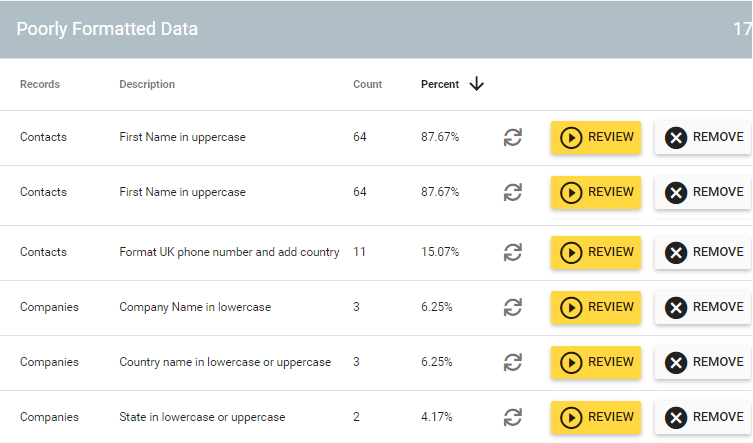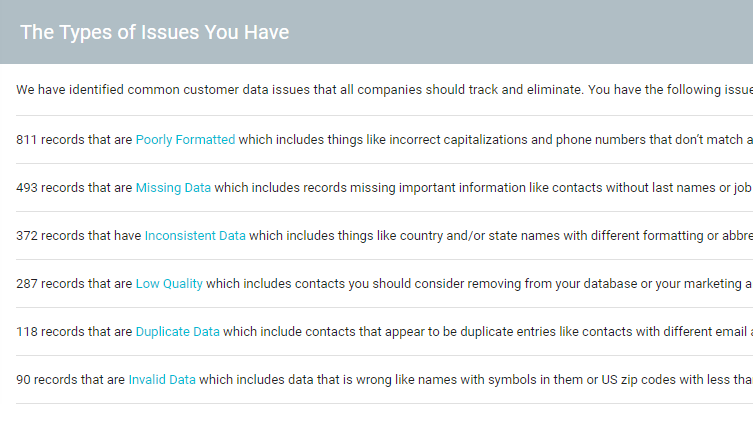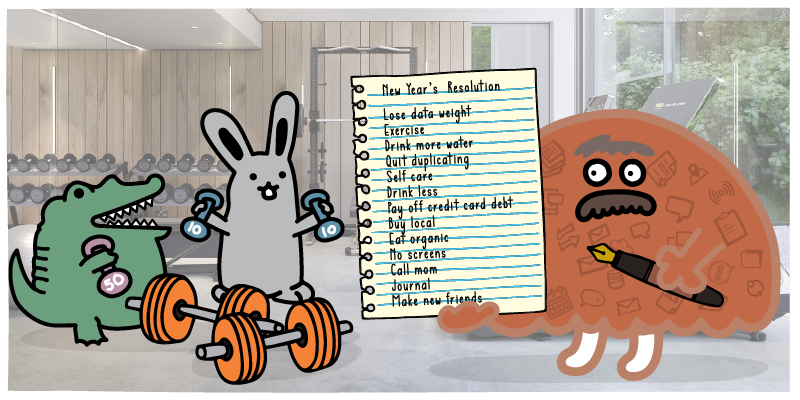Every New Year brings a fresh start. We can clean the slate, set new goals, and focus on new tasks. So what are your business New Year’s resolutions?
If one of those resolutions isn’t “take control of my customer data,” it probably should be. But that requires investments — data management software, customer data platforms, etc. Taking customer data management seriously will pay off for your company for years to come, but getting everyone on board can be difficult.
Effective customer data management begins with a commitment. A top-down approach to data management will provide a single customer view that improves customer service, marketing campaigns, and sales initiatives.
The truth is that most companies pay far too little attention to the quality of their customer data. Errors in their data only become a priority when it actively impacts them in some major way, with all of the little ways that depleted data quality chips away at your profitability over time being swept under the rug.
The thing is, if you collect even a small amount of customer data, it’s nearly always worth your time to improve data quality, even if by hand. Using powerful tools like Insycle — which can cut your data management time investment to about 10% of what it would be if you used Excel — only deepens its impact.
In this article, we’ll outline all the steps companies need to take to create a customer data management plan and take control of their data.
1. Prepare to Document Everything
This point can’t be understated. You have to document everything when putting together a customer data management strategy. To improve data management, documentation is the only thing that can take you to the next level.
Problems beget problems when it comes to data. If you dive into a data audit, you’ll find many errors within your database. It’s just a natural part of data collection. If you don’t document the types of data issues you see, they’ll quickly be forgotten after more arise.
When you notice amiss something in your data, write it down. Document it. In doing so, you’ll give yourself a leg up later down the line when it comes time to fix issues and optimize data collection strategies to improve quality.
Document where your data is stored, including cloud solutions, CRM platforms, and backups. Document the processes that you use to enter or update data into your system, including bulk .CSV imports between platforms. Document how marketing, sales, and customer support teams pull data from your systems and utilize it within their work.
A full picture of your data operations will make it easier to spot data collection, storage, and utilization issues down the road.
Throughout the process of auditing and cleaning your data, take notes. Many data errors come down to how the data was collected or transferred. In noting these issues, you give yourself a chance of identifying why they showed up in the first place
Using Insycle's Health Assessment to Aid Documentation
Often companies create documentation, but due to the breadth of knowledge required and technicality of the instructions — it doesn't always translate to others the way they would have hoped. Sometimes identifying what needs to be done to fix a specific data issue can be difficult for anyone who is not familiar with the involved systems.
That's where Insycle's Customer Data Health Assessment tool comes in. It can greatly help the data health tracking and documentation process.
Out of the box, the health assessment tracks 30+ common customer data issues across 6 categories. However, you can create custom templates to track issues unique to your organization and the data issues you encounter.

2. Audit Your Customer Data
To understand where your data problems lie, you have to take a long, hard look at the data. Companies that only keep a loose watch on their data quality inevitably end up with customer databases that are chock-full of common errors and other issues.
Allowing those customer data issues to stack up over time makes data cleanup a huge job down the road. It’s always better to have a real customer data management plan in place and chip away at issues over time, rather than waiting to do it all at once.
Identify Data Locations & Bring In Stakeholders
We all wish that we could keep our data silo-free and put ourselves in a position to easily share data across teams. However, the reality in most companies is that some data is collected and overseen by a specific department, and only they have easy access to it.
It’s possible that you have relevant customer experience, marketing, sales, or support data that lives in their respective departments. Just because those departments oversee and manage the data doesn’t mean it should be left out of your data management strategy.
In fact, it’s critical that a key piece of your strategy be to break down those data walls when it makes sense. If your sales team could use customer experience data to provide better experiences to upsell candidates — why not give them the tools they need?
Only start auditing your data when you are sure you aren’t missing siloed data. Bring in stakeholders to ensure that you understand the data's sources and how it can be accessed and shared for your audit.
Bring Platforms Up to Date
Most companies have a few customer data-related tasks that have been sitting on the backburner for a while. Maybe they need to import a list of leads from a local conference. Maybe they’ve been waiting to import data from one platform to another.
Get those tasks out of the way before your data audit and cleansing. There is no reason to import a bunch of dirty data into a freshly-cleaned database. Ensure that all your relevant CRMs and customer data platforms are up to date and ready for a full audit.
Assessing Customer Data Quality
With those things in place, you can begin assessing the quality of your customer data. This in and of itself is a time-consuming task. You can only fix the issues that you know you have.
Most companies use Excel, which is a good starting point. We covered 22 different Excel formulas that marketers can use to clean and assess their data in a recent blog post.
But for companies with larger customer databases, that can be an issue. Excel is prone to crashing when files get too large, and traditional database platforms can be complicated and difficult to use.
Insycle makes it easy to see what problems you have in your customer data with our Customer Data Health Assessment tool.
The Customer Data Health Assessment scours your database, identifying more than 30+ common data errors across more than six issue categories. Then, the Health Assessment provides direct links to fix those issues within Insycle.
When it comes to assessing customer data quality, the Insycle Health Assessment tool provides the simplest and cleanest way to analyze your data and identify issues without having to spend days working inside of an Excel spreadsheet.
Customer Data Accuracy
Just because a record doesn’t have visible errors doesn’t necessarily mean that the data inside is accurate. B2B data becomes outdated very quickly. People move jobs. They change emails. They receive promotions. With each change, B2B databases become increasingly outdated.
So beyond looking for errors and issues, evaluate your data accuracy. You can use a data enrichment tool to help you keep records up to date and flesh out records that have missing data.
Customer Data Consistency
How consistent is your data? How often do you encounter formatting issues for fields like phone numbers, addresses, or states? Do names have proper capitalization in place? If you don’t have proper validation on customer and internal-facing forms, you can almost be sure that your customer database will be chock-full of consistency issues.
Evaluating Data Collection Processes
As part of your audit, you have to look at where your data is coming from and compare that to the types of issues that you see to find the root cause of those issues.
Whether you are collecting customer data through forms, buying lead lists from a vendor, conducting outreach, or connecting through advertising campaigns (or all of the above) — having the proper processes in place to ensure accurate and standardized hits your database in the first place will reduce issues down the road.
3. Clean Your Customer Data
Now that you’ve performed your customer data audit and know all the issues within your datasets, it’s time to start cleaning your customer data. We recently published a CRM Data Quality Checklist that walks you through common issues and the standard order in which they should be fixed.
While you are sure to have some unique data issues due to your combination of collection and storage strategies, there are a few common data issues you are likely to find in every database.
Standardization and Formatting
Make sure that all data in specific fields follows the same format. This way, you can limit potential issues if you automate processes or connect your CRM to another tool.
Take phone numbers, for instance. There are many ways to express a phone number in data:
- 1234567890
- 123-456-7890
- (123)4567890
- (123)-456-7890
- 1-123-456-7890
- 123.456.7890
But what if you want to load your customer data into an auto-dialing solution, just like Kitchen Magic did when they started working with Insycle? Depending on the solution, they might require a specific input. Not having the right format could be the difference between a prospect receiving a call or not.
Beyond integration considerations, you may want to make sure that phone numbers are formatted consistently to ensure they are easily readable by your sales teams, who may make dozens of calls daily.
These same standardization and formatting concerns can apply to many fields in your average customer database. Addresses share similar concerns. Even things like state names have their own problems (New York vs. NY). Many fields do when you sit down and look at what ends up in your database, and preparing for all of them is impossible. You can only hope to fix them.
Part of the data cleansing process is finding the best way to standardize and format your customer data.
Merge Duplicate Customer Records
Duplicate HubSpot contacts create some serious problems. They break the veil of a single customer view, splitting important data and context between multiple records. They can slow your marketing and sales teams down. Duplicate data can lead to embarrassing marketing automation mistakes that harm your brand's reputation.
Ensuring you can identify and merge all duplicate data in your customer database is critical. Using Insycle, you can identify duplicate records using any field in your database (most CRM solutions with duplicate data detection use only names and emails).
Insycle also allows you to bulk merge duplicates instead of manually merging them. In large databases, that alone could save you hours of work. Before your changes go live, you can generate an .CSV report and run the changes in “preview” mode to double-check things before pushing it to your live CRM. Additionally, you can schedule automated deduplication on a daily, weekly, or monthly basis with Insycle.
Remove Redundant Data
Redundant data increases storage costs and can lead to team confusion. For instance, if you import customer data into a CRM from multiple sources, you may see the same data represented in multiple ways.
These fields could all mean the same thing:
- Location
- Company Headquarters
- City
- Address
- HQ
If you import data from many sources, you may end up with 3+ redundant fields for the same data point. Make sure that you are identifying redundant data and merging or removing it, depending on the right choice for your situation.
Having redundant fields makes it difficult to leverage your data effectively. You’ll need to be an expert to know which fields to use to create simple campaigns or for lead scoring. For instance, having both “HQ” and “Headquarters” can be confusing. At first glance, you might assume they are the same. They look the same. But without actually digging through the data, there’s no way to know for sure.
Redundant data costs you money. It harms your sales and marketing initiatives. It increases your data storage costs. It creates confusion among your teams.
Fill Missing Fields
Lead enrichment is a critical part of and customer data management plan. When it comes to critical fields that play a key role in your marketing or sales initiatives, there is no excuse for leaving those fields empty and missing opportunities.
Make sure to have a data enrichment plan in place — whether driven by internal research, through using third-party platforms, or engaging with customers — you have to find critical missing customer data and flesh out profiles. Even with a lead enrichment plan in place, you need proper employee training to monitor effectiveness and ensure that relevant information is being entered at every stage. Missing fields can harm lead scoring initiatives and lead to misplaced prioritization among sales and marketing teams.
Put Together Plans for Ongoing Data Cleaning
For data cleaning to be fully effective, it has to be an ongoing task. Doing a big data clean once per year is better than not cleaning, but still allows dirty data to sit in your database and impact your marketing and sales campaigns throughout the year.
You should clean your data in earnest once per month, at minimum. Using Insycle, you can schedule automated data cleaning processes to run hourly, daily, weekly, or monthly. With automation, you can ensure that your customer data is clean year-round.
4. Evaluate Data Collection Methods
With your data errors cleaned up and your quality improved, it’s time to turn your attention to the methods that you used to collect that dirty data in the first place. By installing proper processes and validation, you can help to limit the amount of dirty data that hits your HubSpot, Salesforce, or Intercom account in the first place.
Some of the different data collection methods that you should take a look at include:
Customer Forms and Inputs
If you have contact forms that customers can fill out that automatically feed your CRM, it’s important that you take a good, hard look at these forms. What information are you asking customers for? Do the fields have proper validation in place to ensure that you send clean, standardized data?
Customer inputs are one of the most common sources of low-quality data, but you can do a lot to improve the data quality through these channels by installing proper form validation and identifying other customer-facing data collection improvements.
Internal Inputs
It isn’t just your customers, it’s your own teams too! Any time a human manually enters data, there is an average of a 1% data entry error rate on each keystroke.
Install deep validation in the forms you use to enter data into your CRM internally. Ensure that you provide clear directions for each field and have processes in place for searching for and identifying duplicates before entering or importing new data into your CRM.
Importing Concerns
There are always issues with importing data. The data fields between the two platforms might not match up. They may collect fields using different formats. There may be actual processing errors, which lead to weird data issues. Make sure you understand what issues come from the different types of data imports that you make.
Staff Training and Education
Last but definitely not least, you need to ensure that you have the proper staff training and ongoing education processes for handling data and customer data management. When your staff understands the importance of clean data, they’ll be much more likely to handle it carefully and take steps toward cleaning it before importing it.
Providing your staff with content on why clean data is so important can give you simple ways to keep the issue top-of-mind and allow your employees to return to learn more whenever they’d like.
Your customer data management plan should include outlines for the different training types and supplemental content you plan to provide. Even if it’s just a short meeting that discusses the key points, you can make sure that your team has data quality on their minds.
5. Consistently Work Toward Better Customer Data
As you put together your customer data management plan, know that quality data comes from a continuous effort to improve and not from a single data cleaning.
Your customer data management plan should encompass more than your initial efforts. It should include all changes you will make to facilitate better customer data on an ongoing basis.
Consistently working to identify mistakes and build out processes to improve your data collection will reduce issues and improve data quality over time.
Insycle — Your Complete Customer Data Management Plan Tool
Insycle is a data management software tool for auditing customer data, identifying issues, fixing them, and automating ongoing data cleanup processes. Insycle's data management system makes it easier than ever to identify problems in your data and fix them.
When you sign up for Insycle's 7-day free trial, your first Customer Data Health Assessment, which will help you scan your database and identify 30+ of the most common customer data issues.

This will help you to gain a top-down view of your data quality. Then, you can click the “Fix” button, and you’ll be taken to the right Insycle tool with a pre-loaded template for fixing every issue the Health Assessment identifies.
Want to get started? Sign up today to access your Free customer data health assessment and begin putting together your customer data management plan.






